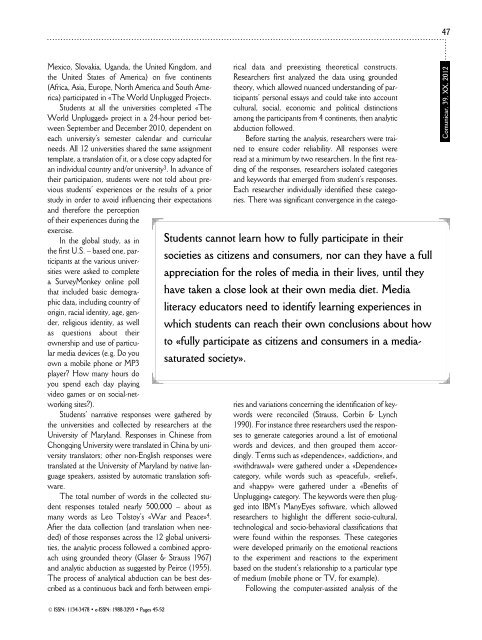Comunicar 39-ingles - Revista Comunicar
Comunicar 39-ingles - Revista Comunicar
Comunicar 39-ingles - Revista Comunicar
Create successful ePaper yourself
Turn your PDF publications into a flip-book with our unique Google optimized e-Paper software.
47Students cannot learn how to fully participate in theirsocieties as citizens and consumers, nor can they have a fullappreciation for the roles of media in their lives, until theyhave taken a close look at their own media diet. Medialiteracy educators need to identify learning experiences inwhich students can reach their own conclusions about howto «fully participate as citizens and consumers in a mediasaturatedsociety».Mexico, Slovakia, Uganda, the United Kingdom, andthe United States of America) on five continents(Africa, Asia, Europe, North America and South Ame -rica) participated in «The World Unplugged Project».Students at all the universities completed «TheWorld Unplugged» project in a 24-hour period betweenSeptember and December 2010, dependent oneach university’s semester calendar and curricularneeds. All 12 universities shared the same assignmenttemplate, a translation of it, or a close copy adapted foran individual country and/or university 3 . In advance oftheir participation, students were not told about previousstudents’ experiences or the results of a priorstudy in order to avoid influencing their expectationsand therefore the perceptionof their experiences during theexercise.In the global study, as inthe first U.S. – based one, participantsat the various universitieswere asked to completea SurveyMonkey online pollthat included basic demogra -phic data, including country oforigin, racial identity, age, gender,religious identity, as wellas questions about theirownership and use of particularmedia devices (e.g. Do youown a mobile phone or MP3player? How many hours doyou spend each day playingvideo games or on social-networkingsites?).Students’ narrative responses were gathered bythe universities and collected by researchers at theUniversity of Maryland. Responses in Chinese fromChongqing University were translated in China by universitytranslators; other non-English responses weretranslated at the University of Maryland by native languagespeakers, assisted by automatic translation software.The total number of words in the collected studentresponses totaled nearly 500,000 – about asmany words as Leo Tolstoy’s «War and Peace» 4 .After the data collection (and translation when needed)of those responses across the 12 global universities,the analytic process followed a combined approachusing grounded theory (Glaser & Strauss 1967)and analytic abduction as suggested by Peirce (1955).The process of analytical abduction can be best describedas a continuous back and forth between empiricaldata and preexisting theoretical constructs.Researchers first analyzed the data using groundedtheory, which allowed nuanced understanding of participants’personal essays and could take into accountcultural, social, economic and political distinctionsamong the participants from 4 continents, then analyticabduction followed.Before starting the analysis, researchers were trainedto ensure coder reliability. All responses wereread at a minimum by two researchers. In the first readingof the responses, researchers isolated categoriesand keywords that emerged from student’s responses.Each researcher individually identified these categories.There was significant convergence in the categoriesand variations concerning the identification of keywordswere reconciled (Strauss, Corbin & Lynch1990). For instance three researchers used the responsesto generate categories around a list of emotionalwords and devices, and then grouped them accordingly.Terms such as «dependence», «addiction», and«withdrawal» were gathered under a «Dependence»category, while words such as «peaceful», «relief»,and «happy» were gathered under a «Benefits ofUnplugging» category. The keywords were then pluggedinto IBM’s ManyEyes software, which allowedresearchers to highlight the different socio-cultural,technological and socio-behavioral classifications thatwere found within the responses. These categorieswere developed primarily on the emotional reactionsto the experiment and reactions to the experimentbased on the student’s relationship to a particular typeof medium (mobile phone or TV, for example).Following the computer-assisted analysis of the<strong>Comunicar</strong>, <strong>39</strong>, XX, 2012© ISSN: 1134-3478 • e-ISSN: 1988-3293 • Pages 45-52
















